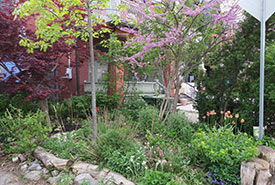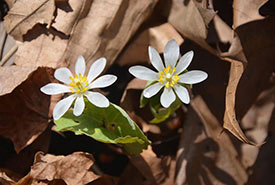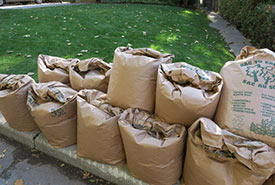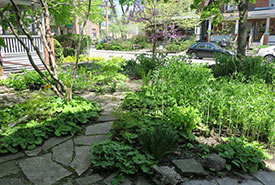We’re in a biodiversity crisis. What we plant and how we alter landscapes matters

Front yard naturalization in spring. (Photo by Lorraine Johnson)
Spring hadn’t officially sprung, but the season was warm, and so the annual ritual began. People began to clean up the dried stalks and dead leaves protecting the earth. While tidying up, people were also throwing out countless insects — a generation of bees, butterflies and other beneficial creatures that spend the winter as larvae, pupae or adults in the rich organic materials we call mess.
Many conventional landscape practices have unintended negative consequences for biodiversity. Leaf blowers blast habitat into yard “waste” bags, which are trucked away from the soil that could benefit from their nutrients. Dead stalks from last year’s plants are cut and bundled at the curb; all the cavity-nesting bees they harbour are sent to be composted.

Bloodroot blooming in spring through last year’s dead leaves (Photo by Lorraine Johnson)
Municipal governments are complicit by encouraging yard “waste” collection when the snow has barely left the ground. What if collection were delayed or reformed, and we followed nature’s rhythms? Dead leaves and stalks left on the landscape to do what they do naturally: regenerate and nurture resilience. Surely spring is the time for slow emergence, the gentle awakening of life.
Meaningful change will take more than a re-tweaking of waste schedules. It will require a cultural shift, a rethinking of who we create and manage urban landscapes for. It can’t come soon enough. We’re in a climate emergency and a biodiversity crisis, and what we plant and how we alter landscapes matter. Individual choices add up — to the crisis we find ourselves in, or to a significant part of the solution.

Yard “waste” is anything but. Dead leaves and stalks left on the landscape to do what they do naturally: regenerate and nurture resilience. (Photo by Lorraine Johnson)
Consider the lawns we’re told are our civic duty to maintain. They are the ecological equivalent of dead zones for wildlife. Think of the native bees searching for nectar and pollen, only to encounter neighbourhoods of manicured lawns. Because the foraging range for wild bees is small — from 500 metres to roughly 1.5 kilometres — what we plant makes a huge difference to local pollinators.
Grass and weeds bylaws send a powerful message that deviation from the lawn with biodiverse, nature-inspired plantings is somehow suspect. It wasn’t long ago that you could be fined for growing milkweed, the larval host for the endangered monarch butterfly. Deregulating one “weed” at a time won’t get us where we need to be. The biodiversity and climate crises call for bold action — a wholesale rethink of what we perceive as appropriate in landscapes.
The science is clear: habitat loss and fragmentation cause species loss and worsen the effects of climate change. We need to protect remaining habitat, but we also need to create it in places where we have green-paved it with lawns and non-native species. When we fill urban landscapes with introduced [non-native] plants, we are severing crucial, dependent relationships between native plants and wildlife that have evolved over millennia. These partnerships and interdependencies support all life on Earth, including us.
We need to plant native plants, and we need to plant them in natural communities — woodland gardens, meadows, prairies, rain gardens.
Our cities need to support efforts to create habitat, not simply with fact sheets but with a commitment to leadership: tax incentives for habitat creation, pollinator workshops in every ward, native planting demonstrations at municipal buildings, native plant give-aways to community projects and more.

A woodland garden in a front yard (Photo by Lorraine Johnson)
The enormous municipal efforts devoted to growing or purchasing non-native annuals for parks and community spaces should be devoted to native plant production in the city’s greenhouses or to purchasing plants from local native plant nurseries. We would have the same beauty in our public plantings but with exponentially more ecological value. The native plant nursery industry would be kickstarted into economic health, not with government handouts but by cities putting their purchasing power in service of biodiversity.
For too long, we’ve collectively defined value through an economic lens with little accounting for the ecological wisdom of our choices. Here’s a challenge: go outside, look around, and celebrate the priceless value of bees, birds, butterflies and beneficial insects. Greet them with a warm spring welcome. Plant native plants and observe the natural relationships and processes of life. Invite natural ecosystems and their lifecycles of bloom, death and decay into the places we live. These nurtured relationships and processes are the true beauty and value of gardening.
Lorraine Johnson and conservation biologist Sheila Colla are co-authors of “A Flower Patch for the Rusty-Patched Bumblebee,” available as a free download from foecanada.org/bee-garden-guide.
This story originally appeared on the Toronto Star’s website and is reposted with minor edits, with permission from the authors.




